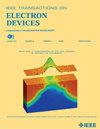A Facile Approach to Fabricate QCM Humidity Sensor Based on Molybdenum Disulfide/Cellulose Nanocrystal Thin Film
IF 2.9
2区 工程技术
Q2 ENGINEERING, ELECTRICAL & ELECTRONIC
引用次数: 0
Abstract
In this article, molybdenum disulfide (MoS 2 )/cellulose nanocrystal (CNC) nanocomposites are coated on silver electrodes of the quartz crystal microbalance (QCM) by the drop-coating method for humidity sensing. The performance of QCM humidity sensors of MoS 2 , CNC, and MoS 2 /CNC thin films is investigated in the relative humidity (RH) range of 11.31%–97.59%. The experimental results reveal that MoS 2 /CNC humidity sensor has high sensitivity (ca. 36.03 Hz/%RH), which is higher than CNC (ca. 1.25 times) and MoS 2 (ca. 2.5 times). Meanwhile, the sensor has excellent repeatability, high stability, and low humidity hysteresis (ca. 3.3%RH). Moreover, the Langmuir isotherm adsorption model is also used to investigate the humidity-sensitive mechanism of MoS 2 /CNC humidity sensors. In addition, MoS 2 /CNC humidity sensor can be well applicable for respiration monitoring which has good application prospect.基于二硫化钼/纤维素纳米晶薄膜的 QCM 湿度传感器的简便制造方法
本文采用滴涂法将二硫化钼(MoS2)/纤维素纳米晶(CNC)纳米复合材料涂覆在石英晶体微天平(QCM)的银电极上,用于湿度传感。研究了 MoS2、CNC 和 MoS2/CNC 薄膜的 QCM 湿度传感器在 11.31%-97.59% 相对湿度 (RH) 范围内的性能。实验结果表明,MoS2/CNC 湿度传感器具有高灵敏度(约 36.03 Hz/%RH),高于 CNC(约 1.25 倍)和 MoS2(约 2.5 倍)。同时,该传感器具有出色的重复性、高稳定性和低湿度滞后(约 3.3%RH)。此外,还利用 Langmuir 等温线吸附模型研究了 MoS2/CNC 湿度传感器的湿度敏感机理。此外,MoS2/CNC 湿度传感器还可用于呼吸监测,具有良好的应用前景。
本文章由计算机程序翻译,如有差异,请以英文原文为准。
求助全文
约1分钟内获得全文
求助全文
来源期刊

IEEE Transactions on Electron Devices
工程技术-工程:电子与电气
CiteScore
5.80
自引率
16.10%
发文量
937
审稿时长
3.8 months
期刊介绍:
IEEE Transactions on Electron Devices publishes original and significant contributions relating to the theory, modeling, design, performance and reliability of electron and ion integrated circuit devices and interconnects, involving insulators, metals, organic materials, micro-plasmas, semiconductors, quantum-effect structures, vacuum devices, and emerging materials with applications in bioelectronics, biomedical electronics, computation, communications, displays, microelectromechanics, imaging, micro-actuators, nanoelectronics, optoelectronics, photovoltaics, power ICs and micro-sensors. Tutorial and review papers on these subjects are also published and occasional special issues appear to present a collection of papers which treat particular areas in more depth and breadth.
 求助内容:
求助内容: 应助结果提醒方式:
应助结果提醒方式:


